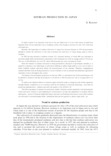Soybean Production in Japan
Tropical agriculture research series : proceedings of a symposium on tropical agriculture researches
| ISSN | 03889386 |
|---|---|
| NII recode ID (NCID) | AA00870529 |

Full text
tars17-_95-102.pdf1.11 MB
In Japan soybean is an important crop next to rice and wheat since it is one of the sources of traditional Japanese foods and an important crop in cropping systems, even though it accounts for only 2.5% of the total cultivated area.
Recently, the importance of soybean cultivation in Japan has increased because in 1978 the government decided to restrict the cultivation of rice and to promote the cultivation of wheat, forage crops as well as soybeans.
In 1982 the area planted to soybeans covered 147.1 thousand hectares, of which 68% was cultivated in converted paddy fields and production amounted to 226.3 thousand tons with an average yield of 1.54 ton/ha. The rate of self-sufficiency was only 5%. About 800 thousand tons were consumed for foods.
Since the increase in soybean cultivation is being pfomoted by allocation of government subsidies, it is essential to develop a new technology of cultivation enabling to achieve high yields at a low cost in order to firmly establish soybean cultivation before the discontinuance of the subsidies. Therefore, comprehensive research and field trials are being promoted at various institutes as well as national and prefectural agricultural experiment stations throughout the country.
According to the government projections, by the year 1990, it is anticipated that 210 thousand hectares will be planted to soybeans and that the production will amount to 420 thousand tons will an average yield of 2.2 ton/ha.
To achieve this objective efforts on extension aspects should be made to enlarge the scale of farm operations through farmers' cooperation so as to increase yields by the adoption of advanced technology ; save labor by promoting mechanization ; enhance and unify the quality of the products; etc.
The following aspects of research are particularly needed : breeding varieties adaptable to late planting after wheat cultivation, resistant to pod shattering for mechanization, having wide adaptability to produce uniform seed quality; control of fusarium blight-like disease and seed coat breaking which tend to occur when soybeans are cultivated in converted paddy fields ; identifying ideal growth patterns to achieve high yields ; etc.
Recently, the importance of soybean cultivation in Japan has increased because in 1978 the government decided to restrict the cultivation of rice and to promote the cultivation of wheat, forage crops as well as soybeans.
In 1982 the area planted to soybeans covered 147.1 thousand hectares, of which 68% was cultivated in converted paddy fields and production amounted to 226.3 thousand tons with an average yield of 1.54 ton/ha. The rate of self-sufficiency was only 5%. About 800 thousand tons were consumed for foods.
Since the increase in soybean cultivation is being pfomoted by allocation of government subsidies, it is essential to develop a new technology of cultivation enabling to achieve high yields at a low cost in order to firmly establish soybean cultivation before the discontinuance of the subsidies. Therefore, comprehensive research and field trials are being promoted at various institutes as well as national and prefectural agricultural experiment stations throughout the country.
According to the government projections, by the year 1990, it is anticipated that 210 thousand hectares will be planted to soybeans and that the production will amount to 420 thousand tons will an average yield of 2.2 ton/ha.
To achieve this objective efforts on extension aspects should be made to enlarge the scale of farm operations through farmers' cooperation so as to increase yields by the adoption of advanced technology ; save labor by promoting mechanization ; enhance and unify the quality of the products; etc.
The following aspects of research are particularly needed : breeding varieties adaptable to late planting after wheat cultivation, resistant to pod shattering for mechanization, having wide adaptability to produce uniform seed quality; control of fusarium blight-like disease and seed coat breaking which tend to occur when soybeans are cultivated in converted paddy fields ; identifying ideal growth patterns to achieve high yields ; etc.
| Date of issued | |
|---|---|
| Creator | S. KONNO |
| Publisher | Japan International Research Center for Agricultural Sciences |
| Volume | 17 |
| spage | 95 |
| epage | 102 |
| Language | eng |
